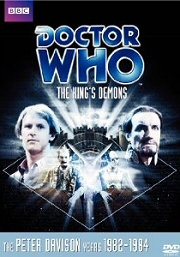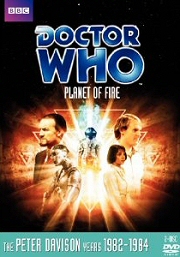Mark Strickson, Anthony Ainley
Nicola Bryant, Anthony Ainley
- Sci-Fi
- 1984
- Buy the DVD
Reviewed by Ross Ruediger
()
ew long-running TV series manage to keep moving forward without the occasional bad idea – the kind where viewers collectively scratch their heads, and in unison sigh, “What were they thinking?” Given how long “Doctor Who” has been on the air in its various incarnations, it’s probably had more than its fair share of half-baked notions. If one were to make a list of such grievances, it seems likely that the Fifth Doctor’s robot companion Kamelion would land comfortably in the Top Five. Apparently, producer John Nathan-Turner wanted a new metallic emblem for the show, as K-9 had been gone for several years, and he’d recently gotten a glimpse of an actual working, moving robot, so naturally he wanted one for the series.
Since this was in 1984 – and here in 2010 robots are still fairly hard to come by – you can imagine that the results were somewhat less than spectacular. Not only did Kamelion look cheap, but the robot itself functioned so poorly that even though the character was a TARDIS crewmember for seven stories, we only ever saw him in two, “The King’s Demons” and “Planet of Fire.” Presumably, in the interim tales, he putters around the TARDIS, left to his own devices (curiously, nobody seemed worried about his fate in “Frontios,” the story in which the TARDIS was temporarily destroyed).
Having just defeated the Black Guardian in “Enlightenment,” the TARDIS has landed in England in the year 1215. And what an entrance it is – the blue police box materializing in the middle of a jousting match! The crew discovers that they’re at the castle of Sir Ranulf Fitzwilliam (Frank Windsor), who just so happens to have King John (Gerald Flood) over for company. The King immediately proclaims the Doctor (Peter Davison), Tegan (Janet Fielding), and Turlough (Mark Strickson) his benevolent demons. Lurking on the sidelines is the Frenchman and King’s Champion Sir Gilles Estram, who is actually the Master (Anthony Ainley) in easily his worst disguise ever. His plan is to prevent King John from signing the Magna Carta, the famed English document which places limits on the King’s power, and he has a useful robotic tool aiding him in his scheme.
No matter what you’ve heard, “The King’s Demons” is not a terrible story. Of course, it isn’t very good, either. Mostly it’s an utterly forgettable one. It’s a two-parter, which of course means it’s practically over before it’s begun. The previous season offered up “Black Orchid,” a far more successful two-part historical by the same writer, Terence Dudley, but “Orchid” had an actual beginning, middle and end. What’s lacking here is any kind of compelling finish, as the story just rather abruptly comes to a close. I would argue that “The King’s Demons” probably could have been a fairly engaging four-parter, of course it would have needed far more story to make that happen, which could have been accomplished any number of ways, not least by explaining exactly why the Master wants to disrupt the Magna Carta signing, as here we never find out.
It also doesn’t help matters that for the entirety of the first episode, Sir Gilles is just so clearly, obviously the Master, with only a slight nose prosthetic and a red wig, and yet the Doctor and his companions never, ever notice. His true identity is revealed at the end of the episode, and he cackles, “Oh my dear Doctor, you have been naïve!” As the viewer you’re baffled and in agreement. And then there’s Kamelion, the robot slave who can change his form to look like anyone his controller him wants him to. (No doubt, he’d make quite the useful sex toy.) The robot itself only has a couple scenes here, and they’re at the end of the tale. He then joins the TARDIS crew and we never see him again until Davison’s penultimate story, which leads us to our next classic “Who” DVD offering.
“Planet of Fire,” to my mind, is the kind of story that separates the men from the boys, and I’m not saying that because its most famous scenes feature Nicola Bryant in a bikini. Indeed, far more than anything else, the story is known for this facet, and she does look pretty smokin’ so it’s difficult to argue. But there’s much more to “Planet of Fire,” provided you have the patience to pay attention, and that’s where the “men vs. boys” analogy comes into play. I’d like to believe that most intelligent, mature viewers would see it as a worthy meditation on the pitfalls of worshipping imaginary deities, and yet it appears that many fans label the story as nothing more than boring, and that’s a shame.
It begins with Kamelion freaking out in the TARDIS, which is followed by a signal coming from Earth. The Doctor and Turlough head for the sunny, Spanish island of Lanzarote (where the bulk of this story was shot) to find the source of the signal. While there, Turlough saves a young American botany student, Perpugilliam “Peri” Brown (Bryant), from drowning, and she ends up onboard the TARDIS when it takes flight for the volcanic planet Sarn. But how did her archeologist stepfather, Howard (Dallas Adams), get onboard the ship as well? All is not as it seems, several times over, and soon enough the Master appears, as do numerous clues leading to a solid explanation of Turlough’s checkered past.
There’s a great deal going on in “Planet of Fire,” and far more than I dare reveal in a DVD review, but it all comes together in the final episode, and makes for a pretty fascinating piece of science fiction. What struck me as unique about it on this viewing was that nearly the entire story is devoted to exploring one of the Doctor’s companions. The alien Turlough had been a mystery since we met him in “Mawdryn Undead,” and finally, here in his final outing, we find out everything about his past, which in the process gives him a fitting, reasonable exit – quite the anomaly for a series that routinely wrote out companions with little more than a few lines of dialogue. (One need look no further than the story prior to this one, “Resurrection of the Daleks,” in which Tegan was written out with a quick, albeit heartfelt, speech that pretty much amounted to “I’m sick of watching people die.”)
Furthermore, all the location shooting on Lanzarote gives the entire affair a much different texture from the “Who” norm, and director Fiona Cumming made great use of what was available to her, with the island subbing for Sarn. This could easily have been unimaginatively shot in the old standard gravel pit, but it’s not, and the results bring a huge amount of class to the proceedings. All this and character actor Peter Wyngarde, too! If I had to pick a major nit, it would be Nicola Bryant’s American accent. As time went on, she managed to cobble together a pretty convincing one, but here in her first outing it’s shaky, wobbling back and forth between the fake accent and her natural British lilt. But since she’s in that bikini, it’s ultimately not something I’m prepared to hold against her.
Special Features: “The King’s Demons” sports a commentary track with Davison, actress Isla Blair, and script editor Eric Saward. It also features a second yak track on Episode One with director Tony Virgo, and he’s so enthusiastic it’s a shame his thoughts on the second episode weren’t recorded as well. “Kamelion – Metal Man” is a featurette mostly devoted to all the problems surrounding the troubled prop. “Magna Carta” is an informative, if not somewhat dry look at the document’s history.
The commentary track on “Planet of Fire” is a lively affair with Davison, Strickson, Bryant and director Cumming. “Return to the Planet of Fire” sees Cumming and designer Malcolm Thornton revisiting Lanzarote and all the locations they used over 25 years ago. “Designs on Sarn” is another interview with Thornton. There’s also a selection of deleted and extended scenes and some continuity announcements. Missing from the Region 1 release is a making of titled “The Flames of Sarn,” which couldn’t be cleared because of some pop songs. I can’t say the set feels incomplete without it, but let’s hope this doesn’t happen again.
But wait – there’s more! There’s a second disc on “Planet of Fire” which features an all-new movie edit of the story akin to the one that was done last year for “Enlightenment.” It whittles the story down to a brisk 66 minutes and features an all-new pre-credits sequence, as well as presents loads of new effects work. Problem is, unlike the “Enlightenment” edit, this one just simply doesn’t gel. It moves at a breakneck, almost jarringly uncomfortable pace (particularly in the first half of the story) and ends up cutting out far too much of the charm that makes this story tick. It’s worth a view, sure, but it’s unlikely that you’ll be revisiting “Planet of Fire” through this version after you give both versions a look. I’m not against further such attempts at revisionism, as long as the original edit sits alongside the redux, but next time, I think the powers that be need not be in such a hurry to cut what might be deemed padding, since it’s often the little moments in between the big moments that make “Doctor Who” the program that it is. Also on the second disc is some behind the scenes material and a retrospective on Anthony Ainley that can only be called something of a letdown.
Both releases also feature the usual photo galleries, PDF Radio Times listings, and production notes options and also isolated scores, as well as the same “Coming Soon” trailer for “The Dominators,” which isn’t actually coming all that soon. Maybe in January, but that remains to be seen.
You can follow us on Twitter and Facebook for content updates. Also, sign up for our email list for weekly updates and check us out on Google+ as well.














